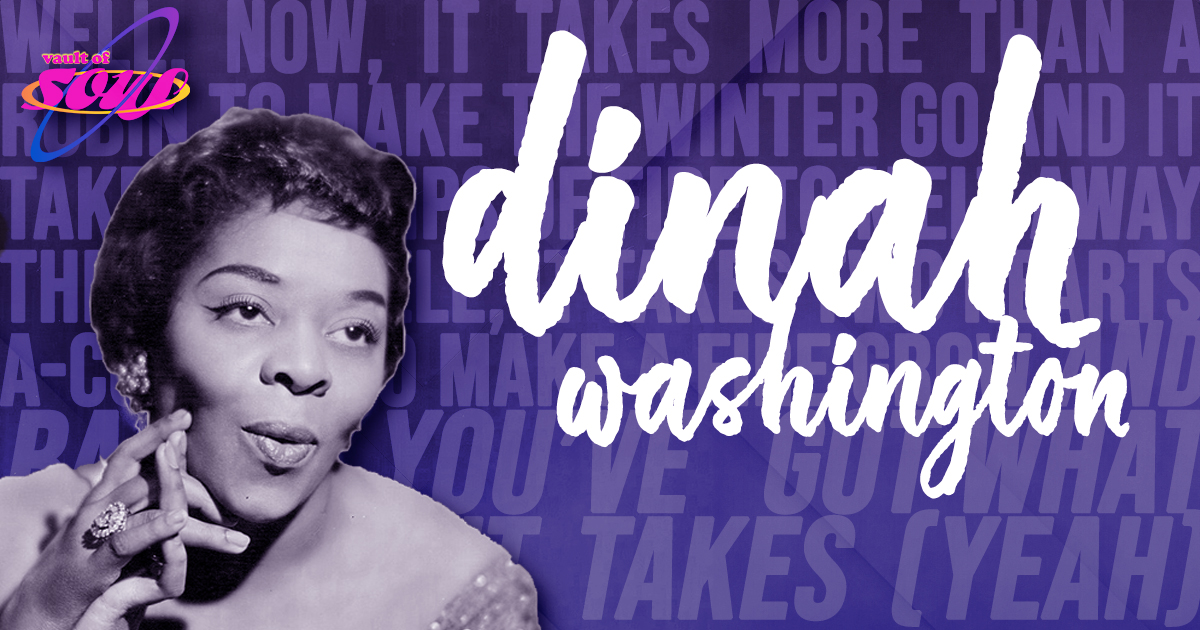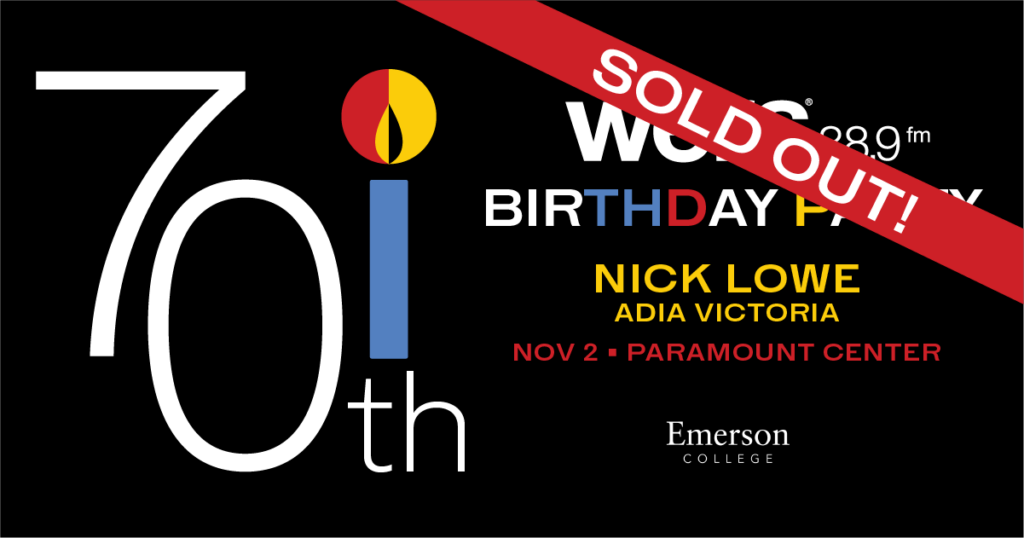
Make way for the Queen of the Blues— Dinah Washington kicks off our Vault of Soul series this Black Music Month! Each week of June we open the 88.9 Vault of Soul with profiles of iconic soul pioneers. As we take a deep dive into Dinah Washington’s history, career, influences, and of course her success, we hope you come out of it as enlightened as her legacy.
By Riley Vecchione, Digital Marketing Specialist
BIOGRAPHY
Dinah Washington was Alabama-born under the name Ruth Lee Jones on August 29th, 1924. (She would not be known as her stage name Dinah Washington until 1942 during her rise to stardom). As a child, her vocal roots began in the churches of Chicago where she flourished in the vibrant gospel community found there. But she was not to be pigeonholed within any one genre; Chicago’s music scene being so vibrant built a versatile and robust foundation for Washington, who would inevitably become an icon known for her range.
THE RISE OF THE QUEEN
Gospel ran in Dinah Washington’s blood. Her mother, Alice, was a figurehead of their church’s choir in Chicago. Following in her mother’s footsteps, Washington charged full speed ahead into the world of soul as a young girl starting at St. Luke’s Baptist Church on Chicago’s South Side. It wasn’t long before she earned herself a reputation among the community, launching herself to other churches by the time she was just fifteen years old. People would come from all over the city to hear her voice, and this was only just the beginning.
That year brought with her a milestone that would snowball into a life-changing series of events: Winning an amateur singing contest at Chicago’s Regal Theater in Chicago’s Bronzeville neighborhood. The lavish velvet-adorned venue was famous for hosting many performances starring African American talent from all walks of life - and as young Washington took the stage to show off her chops, bringing forth everything she’d honed thus far, she earned herself a resident spot in the Sallie Martin Gospel Singers. This became the start of her professional career.
THE TRANSITION FROM RUTH TO DINAH
In 1942, three years after that serendipitous win at the Regal Theater’s amateur singing contest, the now-professional singer Dinah was scouted by one of the trailblazers of the jazz movement: Lionel Hampton, a vibraphonist. Known for being one of the first musicians to implement the vibraphone into jazz, he too shared Alabama roots with Dinah and was immediately drawn to the power of her voice. With her talent, it only made sense for him to invite her to join his band, the Lionel Hampton Orchestra. Pumped with energy and swing-centric dynamism, Lionel’s band was a perfect fit for Dinah’s next steps. From there she grew from professional gospel singer to professional jazz and blues singer.
This pivot in genre set the stage for another step in her career — a name change, formally going from Ruth Lee Jones to a name that would become iconic: Dinah Washington. In 1925, Lionel dedicated a song to her, titled “Dinah,” which would go on to be revered as a staple in the jazz scene.
Her stint with the Lionel Hampton Orchestra brought the hit song “Evil Gal Blues” in 1943, which earned her a spot as a rising pioneer in the rapidly-growing jazz and blues world. It garnered national attention due to her powerful vocals accompanying lyrics such as “I’ll empty your pockets and fill you with misery” and “If you tell me good morning, I’ll tell you that’s a lie.” The upbeat devil-may-care swingstyle of her vocal deliveries would be yet another addition to her vibrant repertoire of range, carrying her through a successful chapter with Lionel’s band.
OUT OF THE NEST: HER SOLO CAREER
“Evil Gal Blues” was just the start. Other famous tracks during her time with Lionel would send her closer to the biggest jump yet— a solo career. In 1948, Mercury Records signed her on. Being a pioneering label, it prided itself on differentiating itself from the leading labels of RCA, Columbia, and Decca; spanning across many genres and refusing to pigeonhole, Mercury Records would be Dinah’s home for the next fifteen years.
This flexible atmosphere for a record label gave Dinah the freedom to experiment and grow, dabbling in even more genres. She meshed and mixed influences among jazz, R&B, and pop. Dinah was known for hit after hit, such as “Trouble in Mind” and “For Those in Love.” But above all else, what sent her spiraling from rising stardom to full-on fame, happened in 1959. Her rhythm and blues rendition of the 1930s song “What a Diff’rence a Day Makes!” became an instant household staple, and earned her a well-deserved Grammy Award for Best R&B performance.
We lost Dinah far too young, before her time. She passed away in a fatal car crash at age 39. Fans continue to honor Dinah for her talent, skill and gift she shared with us.
WHO DINAH WASHINGTON INFLUENCED
Aretha Franklin: The Queen of Soul was inspired by the Queen of Blues, deeply. Aretha Franklin’s animated, emotional deliveries and vocal power were inspired by the road paved before her by Washington’s legacy. No doubt as well, the fearless fusion of genres Washington embodied also led to Aretha’s own style as well. Both of these women set themselves apart from the norm. Aretha’s music is not a mirror-reflection of Dinah’s but rather a look all her own, framed by the foundation Dinah paved.
Etta James: Known for her way to command the stage and the speakers alike with her powerful voice and presence, Etta James has Dinah Washington to thank for setting a standard. The musical affinity to the blues genre is also due in part to Washington’s legacy. There is a rawness and realness about Washington's voice that, too, is found in James’ performances. These women were not to be bound by genres but instead sought to trailblaze their own eclecticism.
Nancy Wilson: Nancy Wilson is known first and foremost for her versatility. A chameleon of sorts, able to bob and ebb through blues, jazz, R&B, and pop. Sound familiar? Dinah’s legacy set forth motion to Nancy’s own, where she didn’t just sing songs: she put her entire self into them. No matter where her voice took her, the roots of jazz and blues stayed strong-woven within her sound, much like Washington.
WHO INFLUENCED DINAH WASHINGTON
Lionel Hampton: Lionel Hampton’s mentorship shaped her career as she transitioned into new genres from days singing Gospel in churches. Due in part to his own iconic presence in the jazz and swing scenes, his influence in the shifting of its sound and what could be done with its potential, he was a valuable source of inspiration in showing Dinah that she could pave her own way too.
Ethel Waters: African-American Gospel at its finest, Ethel Water’s music would have been prevalent in young Dinah’s life. She, too, was no stranger to fusing cross-genres of blues, jazz, and gospel together.
Bessie Smith: Where Dinah Washington as the Queen of Blues, we call Bessie Smith the Empress. She was widely renowned in the Jazz Age and is crowned as one of the greatest performers of her era. Classic and timeless, her smooth and strong vocals would have influenced a young Dinah Washington studying the Greats.
SONG ANALYSIS:
“THIS BITTER EARTH” (1960)
Talk about chills. Dinah’s voice, accompanied by the delicate and bemused realism woven into the lyrics, makes this song one where you sort of just stare up at the early-summer sky and watch the clouds go by. Sing it to me, Dinah: “What good am I? Heaven only knows.” It speaks of a sort of jaded, lopsided sadness; a realist outlook that calls out heartbreak and coldness as a part of life.
But just as life has these moments, they are not the only things that can define us. She closes out the song in such a way that makes me feel like she’s speaking to me directly, or in such a way that I imagine myself staring starry-eyed in a low-lit jazz club with a sidecar in hand, sighing wistfully as she says: “And this bitter earth, ooooh” (and oh, that oooh); “may not, ohh, be so bitter, after all.” Thank you Dinah; I needed that.
“CRY ME A RIVER” (1959)
The jittering strings at the beginning set the stage for a vibe almost quietly sinister as Dinah’s voice sways us through a tale that has me rooting for her broken heart.
There’s a quiet and dark beauty about the first half of the song. It's slow and creeping as she recounts the tale of her broken heart. It is only natural for her to want them to hurt too, but then — for just a moment — her tone is juxtaposed with an upbeat guitar and a little bounce to it. Cheeky, almost. She’s taking us on a ride where she wants to go, and I’m here for it. But only for a moment, before it fades back into that sway, those strings. Smug and heartbroken all the same, you can hear the world-weary smirk in her voice, maybe feel how it would reach her eyes as she sang it long ago.
“BABY, YOU’VE GOT WHAT IT TAKES” (1960)
That’s enough heartbreak and cheeky cynicism, don’t you think? “Baby, You’ve Got What it Takes” is chemistry at its finest. Brook Benton and Dinah Washington pair up in a harmonious duet that makes you sway back and forth, feet tapping to the tempo. There’s something about the sound that transcends genres and decades. A classic “Call and Response” format is featured here, where they both take turns complimenting, flirting and agreeing with one another. This woven overlap of spontaneous conversationalism makes it so you’re never bored. And neither are they, because you can so easily hear the smile in their voices as they take you through the soulful journey of finding that person that makes you go, ‘aha.’
You can revisit past Vault of Soul articles here, featuring artists such as James Brown, Aretha Franklin, Marvin Gaye, and more.
Interested in exploring the soul genre beyond the vault? Be sure to tune into 88.9 every night between 10 pm and 2 am for The Secret Spot. Or, take a deep dive into R&B, Hip-Hop and the legendary voices of Soul alongside new and pioneering MCs by streaming ERS+


